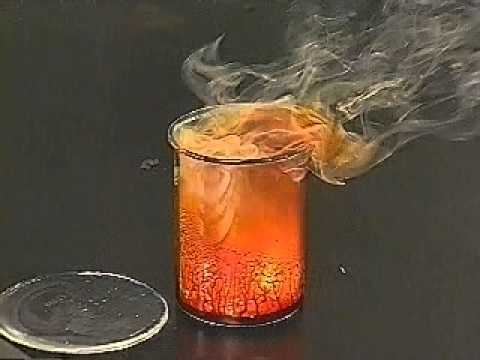Related compounds Molar mass 266.69 g/mol Density 3.2 g/cm³ | Formula AlBr3 Boiling point 255 °C | |
 | ||
Appearance white to pale yellow; crystalline solid | ||
Balancing chemical equations part 4 aluminium bromide and chlorine
Aluminium bromide is any chemical compound with the empirical formula AlBrx. The species called "aluminium tribromide," is the most common aluminium bromide. It is a colorless, sublimable hygroscopic solid, although older samples tend to be hydrated.
Contents
- Balancing chemical equations part 4 aluminium bromide and chlorine
- Structure
- Synthesis
- Reactions
- Safety
- References
Structure
The dimeric form of aluminium tribromide (Al2Br6) predominates in the solid state, solutions in noncoordinating solvents (e.g. CS2), in the melt, and the gas phase. Only at high temperatures do these dimers break up into monomers:
Al2Br6 → 2 AlBr3 ΔH°diss = 59 kJ/molThe species aluminium monobromide forms from the reaction of HBr with Al metal at high temperature. It disproportionates near room temperature:
6/n "[AlBr]n" → Al2Br6 + 4 AlThis reaction is reversed at temperatures higher than 1000 °C. Aluminium monobromide has been crystallographically characterized in the form the tetrameric adduct Al4Br4(NEt3)4 (Et = C2H5). This species is electronically related to cyclobutane. Theory suggest that the diatomic aluminium monobromide condenses to a dimer and then a tetrahedral cluster Al4Br4, akin to the analogous boron compound.
Al2Br6 consists of two AlBr4 tetrahedra that share a common edge. The molecular symmetry is D2h.
The monomer AlBr3, observed only in the vapor, can be described as trigonal planar, D3h point group. The atomic hybridization of aluminium is often described as sp2. The Br-Al-Br bond angles are 120 °.
Synthesis
By far the most common form of aluminium bromide is Al2Br6. This species exists as hygroscopic colorless solid at standard conditions. Typical impure samples are yellowish or even red-brown due to the presence of iron-containing impurities. It is prepared by the reaction of HBr with Al:
2 Al + 6 HBr → Al2Br6 + 3 H2Alternatively, the direct bromination occurs also:
2 Al + 3 Br2 → Al2Br6Reactions
Al2Br6 dissociates readily to give the strong Lewis acid, AlBr3. Regarding the tendency of Al2Br6 to dimerize, it is common for heavier main group halides to exist as aggregates larger than implied by their empirical formulae. Lighter main group halides such as boron tribromide do not show this tendency, in part due to the smaller size of the central atom.
Consistent with its Lewis acidic character, water hydrolizes Al2Br6 with evolution of HBr and formation of Al-OH-Br species. Similarly, it also reacts quickly with alcohols and carboxylic acids, although less vigorously than with water. With simple Lewis bases (L), Al2Br6 forms adducts, such as AlBr3L.
Aluminium tribromide reacts with carbon tetrachloride at 100 °C to form carbon tetrabromide:
4 AlBr3 + 3 CCl4 → 4 AlCl3 + 3 CBr4and with phosgene yields carbonyl bromide and aluminium chlorobromide:
AlBr3 + COCl2 → COBr2 + AlCl2BrAl2Br6 is used as a catalyst for the Friedel-Crafts alkylation reaction. Related Lewis acid-promoted reactions include as epoxide ring openings and decomplexation of dienes from iron carbonyls. It is a stronger Lewis acid than the more common Al2Cl6.
Safety
Aluminium tribromide is a highly reactive material.
